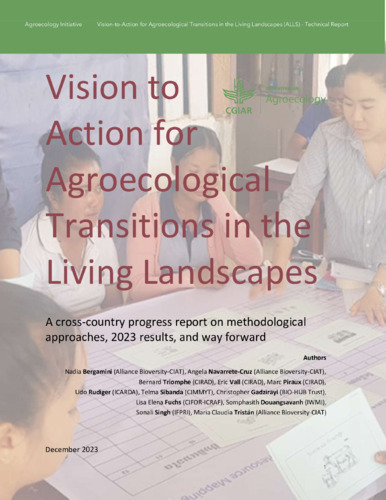Vision to Action for agroecological transitions in the living landscapes: A cross-country progress report on methodological approaches, 2023 results, and way forward
The Agroecology Initiative (AEI) aims to contribute to achieving Agroecological Transitions (AET) through developing and scaling a range of innovations (technical, social, economic, and political) in 8 countries across three continents. It proposes to do so by using a participatory action-research approach involving the key stakeholders of the Agroecological Living Landscapes (ALLs), multi-stakeholder territorial spaces in each country on which the Initiative targets its transformation and innovation efforts. As part of Work Package (WP) 1 titled “Transdisciplinary Co-creation of Innovations in Agroecological Living Landscapes (ALL)”, a visioning exercise was considered as a necessary planning tool for guiding the collective action in the ALLs to trigger agroecological transitions. Explicit vision formulation facilitates the establishment of common goals and the identification of shared challenges that need to be addressed through the collaboration among different types of food system actors. Additionally, a visioning exercise was considered necessary to identify specific agroecological principles to be developed by each ALL and propose the needed actions that can trigger context-relevant transition pathways. Considering this action-oriented approach, the visioning exercise included the development of action plans, identifying food system actors per action and the necessary behaviour changes required by each of them to attain the proposed shared visions. Therefore, the exercise developed was renamed Vision-to-Action (V2A). Far from static images, visions were considered live horizons that necessarily change as the context, assets, actions, capacities, and aspirations of the stakeholders transform partly because of the activities of the AE-I. Therefore, this report focuses on a first iteration of the V2A process in which participatory workshops were
developed by each of the country teams in their respective ALLs. The report also emphasizes the place of V2A in the broader process of ALL establishment, which included activities such as stakeholder mapping, multistakeholder platforms mapping, context assessments (WP2), and value chain analysis (WP3). Additionally, V2A created the necessary bases for the essential co-design processes that must be undertaken as part of WP1 activities. This co-design process is considered as the materialization of the technical innovations that facilitate the context-relevant identification, assessment, and adoption of agroecological practices. The report delves into the proposed methods for developing the V2A workshops, guiding principles, and the actual methodological approach followed by each ALL. The process used for the V2A differs country by country, as adaptations to the guidelines prepared were made to fit with the specific context and arrangements established in each ALL. Diversity across countries can also be explained due to the disparity of expertise and knowledge of the country teams and of national partners facilitating the V2A process. Another element that determined methodological variation across the eight countries was the organization of the territory or how the stakeholder were divided into separate groups. Three approaches were identified. Approach 1 refers to cases of organization of stakeholders or ALL territories by zones considering mainly geographical characteristics of the ALLs and location of the farming systems (Senegal, Lao PDR, and Peru). Approach 2 is based on the organization and separation of stakeholders according to categories (e.g., men farmers, women farmers, public officers). Under this approach discussion took place only among stakeholders corresponding to each category (India, Zimbabwe, Tunisia, and Peru). Under approach 3, separation of stakeholders either by zoning or categories did not exist, and instead, interaction among the different stakeholder categories was broadly encouraged (Kenya, Burkina Faso, and Senegal). These trajectories are not exclusive and indeed, Senegal and Peru developed combinations of two trajectories.
As a result of the visioning exercise, vision statements composed of succinct phrases or sentences which convey, in simple words, the hopes for the long-term (10-15 years) future of agriculture, livelihoods and the territory of the stakeholders who were involved in the process have been developed. Following the methodological diversity and context-relevant nature of the AE-I implementation, some ALLs developed parallel visions/scenarios of the agroecological transition between stakeholder groups, while others proposed a synthesized shared vision. Additionally, the focus of each formulated vision changes according to specific interests such as value chain development and integration, types of farming systems (e.g., family farming), and landscape elements (e.g. watersheds), among others. At the same time, there are recurring topics among countries in the vision statements and objectives that revolve around the three dimensions of sustainability, namely, environmental, economic, and social. Further, integration of the vision statements with the 13 AE principles reflects the prioritization of input reduction, soil health, and economic diversification. Next steps for all country teams will be to ensure the actions they implement indeed are aligned and contribute to achieving the vision (such as the type of innovations they develop or adopt), or also to update, enrich and adjust their vision as perceptions, opportunities and circumstances change, or as some stakeholders leave or join the ALL and hence modify the collective dynamics of change.

